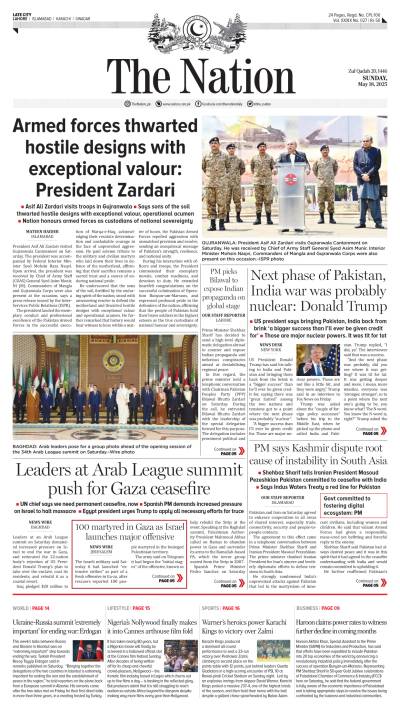It was not a hijacking episode but an ambush staged by the Baluch militants to drown the Jaffar Express in blood on 11 March. The incident was the next in the series of ambuscading buses and setting them alight. The message aired was crystal clear: the lingering discontent in Balochistan was poised to disengage the province from the Centre.
The focus of the militants was two-pronged: the Punjabi domiciled and the army personnel. The former because they have supposedly overwhelmed the Centre; and the latter because they are asserting the will of the Centre. The coalescence of both into one was a disastrous culmination.
The ambush made it clear that there was a present disconnect between the streets and the law enforcers. Of the two, the void was tilted against the latter. In the realm of intelligence on one’s adversary, the militants enjoyed better penetration than the security forces. This happens when the local population sides with the militants. There must be a tacit approval of the hoi polloi. The same portends more such episodes, which is a disquieting sign in the context of the Centre-province relationship.
The ambush revealed that the security forces stationed in Quetta underestimated the growing strength of the militants, ready to surprise with new tactics. No forethought had come into play. Insufficient safety measures (such as a few armed guards with limited ammunition protecting the passenger train) showed an utter lack of concern. It was like abandoning the victims to the will of destiny. Precious lives were lost. Now, excuses are being sought in the argument that the provision of security to the travellers was the provincial subject. In its ferocity and the cover-up excuses, the incident is reminiscent of the massacre in the Army Public School, Peshawar, in December 2014. No head rolled at that time; no head will roll this time.
The ambush cries hoarse that the current provincial governing structure is suspended from the ceiling of the Centre. The ground is heated up, leaving little space for reconciliation on existing terms. Mere enforcement has lost relevance.
Under scrutiny is Dr Mahrang Baluch (a Baluch human rights activist)—whether she condemns the ambush or not. Her response now predicates the future of the Baluch struggle for rights. In December 2023, when she visited Islamabad and staged a protest against enforced disappearances, extrajudicial killings, and mutilated dead bodies of the Baluch, no one paid heed to her entreaties. Having travelled all the way from Turbat, her entourage, comprising women, represented the soft face of the disgruntled Baluch. In response, the Centre lent its deaf ear, showered the assemblage with cold water, and frustrated them into going back empty-handed. On that hapless day, the soft face lost its case. By discounting the efforts of Baluch women, the Centre also lost a great opportunity to reset the discourse. If the Centre had offered certain concessions to make the visiting Baluch women feel successful, it could have driven a wedge between the soft and the hard faces. The militants would have felt isolated socially and defeated strategically. They would have lost their support base, which keeps them emboldened with recruitment and financial help. Moreover, they could not have found the audacity or validation to visit a tragedy upon the Jaffar Express. However, by not availing itself of such a golden opportunity to divide the displeased Baluch, the Centre actually strengthened the resolve of the militants, who consider themselves justified in their despicable actions.
The next month, the delegation of Baluch women returned to Balochistan. Dr Mahrang Baluch narrated publicly how the Centre had treated Baluch women. In rallies, she revealed that Islamabad police had lowered the shalwars (trousers) of peacefully protesting Baluch women to discourage them from protesting. That the Centre could stoop so low was unbelievable. It was as if they were not citizens of this country. After committing this heinous crime, the Centre did not come under scrutiny. This is where the rub lies. The Centre considers itself unanswerable to a province, despite the fact that its mere existence is at the mercy of its constituting units—its provinces. By disrespecting the protesting Baluch women, the Centre ensured that no more such protests would take place in Islamabad.
Friendly relations with China and unfriendly relations with India extend Pakistan sufficient leeway to assume that most Baluch do not harbour any grievance against the Centre. Furthermore, the protesting Baluch (such as Dr Mahrang) are a misguided minority, playing into the hands of antagonistic forces that are averse to provincial development and peace. This assumption has descended the country into mourning the tragedy engulfing the Jaffar Express.
On the one hand, the tragedy is bound to invoke the state’s stern reaction to exterminate the militant Baluch, whereas on the other hand, the tragedy keeps alive the possibility of another such brutal happening. The former is possible because the country has a huge trained army. The latter is possible because Balochistan is a land too vast to comb through. Nevertheless, the main difference lies in the will of the Baluch populace. If they keep on supporting the Baluch militants, the state will remain on edge—otherwise not.
The Centre needs to be cognisant of the fact that, as the name indicates, Balochistan belongs to the ethnic Baluch, whose main concern is that they are becoming a minority in their homeland. Other ethnic minorities, including the Pashtuns, settled as guests. Hence, any path to the resolution of the Baluch issues must pass through the ethnic Baluch.
The Centre must shun its hubris and reopen the closed avenues. It must withdraw the army and make room for politicians to enter into dialogue with the ethnic Baluch.
Dr Qaisar Rashid
The writer is a freelance columnist. He can be reached at qaisarrashid @yahoo.com





